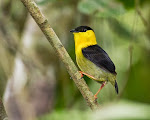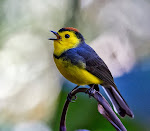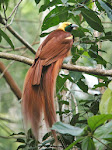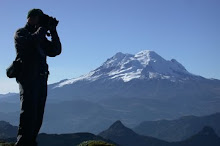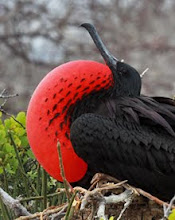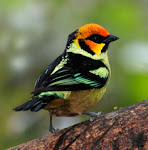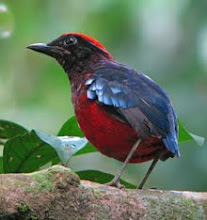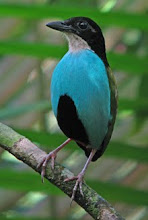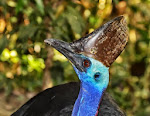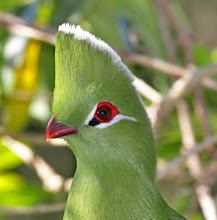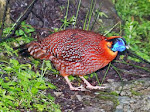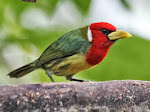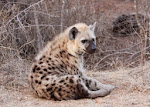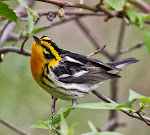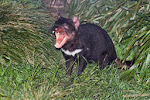Fiery start to our time in the Pacific…
The annals of birding have oft stated that Carara
National Park, located on the Central Pacific, is one of the best of
all the birding hotspots in Costa Rica, but why you might ask? While the
Caribbean side of the mountains is rather uniform in regards to avifauna north
to south, the same cannot be said of the Pacific, where the north is
considerably drier than the humid southern belt of that side. Birders tend to
center their attentions more on the southern side of this, as it holds more
specialties, but why can you not have your cake and eat it too?! Well, Carara
allows just that, sitting in the transition zone where both of these important
biomes collide, it allows a mixed list of species from both zones by locating
yourself at but one lodge, if you so wish. On this challenge/bird race, we
covered both in a flash, starting here in Carara for a taste of Central and
south Pacific birds, before heading into the north Pacific, if only for a brief
spell, at La Ensenada, to give us the best of both avian worlds. We began
with a walk around the immediate property of Macaw Lodge, and while macaws did not feature, the clear
quality of birding available in our brief walk was proven by species like a
male Baird’s Trogon, a handful of Charming Hummingbirds, and Blue-throated Goldentail. However, the
drive down from the lodge was when things really heated up, when German spotted
an avian ember sitting within a roadside cecropia,
the bus was quickly halted, and we were all soon soaking up a fabulous Fiery-billed
Aracari, a specialty
of the south Pacific, (here at the northern edge of its range).
While both other teams headed in earnest for Carara
National Park, which would only seem natural, we tried something
different, a gamble of sorts. We knew that the tide favored a coastal stop in
the morning, and so we headed to the mouth of the Tarcoles River, while
others set off into the forest instead. Here, we were hoping for a flood of
waterbirds to pad the list, but also to indulge in some mangrove species, that
may be difficult come by during our later planned boat trip for such birds in La
Ensenada. Some birds are simply easier with feet planted firmly on the
ground. But here, is where one of my slips will haunt me until the end of
days…German was busy with the ‘scope searching through the wetland species for
the correct wetland species, i.e. ones that would plug gaping gaps on our birds
list. He soon homed in on just such a species, Roseate Spoonbill, and
things were looking rosy indeed. But then I made a gaff. Even though I was
closest to German, and therefore could have locked that bird on the list
swiftly (for someone other than our local guide was required to see/hear the
bird for it to be valid), I chose to continue focusing on the trickier mangrove
birds, leaving the spoonbill for Tim, Niklas and Beltran to count. They were,
after all, only a few steps behind. However, that was soon found to be a few
steps too many, as the normally lacsidazical Roseate Spoonbill took flight, and never appeared on the bird race
again, and so never made it on to our, or any other bird list. And following
the final, tiny margin of loss, this was to be a grave mistake indeed. Such
things make or break a bird race of this nature, and you could say I learnt
something invaluable that day! Our mangrove time did eventually pay off with both
Panama Flycatcher and Mangrove Vireo, the latter of which
took its merry time to reveal its presence in the area. We then shot off to a
little-known area in Orotina, where a certain guide
called Alve is getting a growing
reputation for being able to deliver some of the trickier species of the area
in record time. We were visiting to hope to catch up on a daytime Spectacled Owl, which both other teams
had hanging over us like the Sword of Damocles, as well as other avian stuff
like Lesser
Ground-Cuckoo, Pacific Screech-Owl, Barn Owl, and more.
We started off with the ground-cuckoo, but we knew with limited time this could be the make
or break bird for our time on site, where this was likely to drain time when
least needed. After a nervy time, when the bird remained all but mute, it
suddenly flapped lazily into a thicket, then creeped out into the open, where
it froze for a period! The next search was not quite what we had hoped; in
spite of the Spectacled Owl having
been present the previous afternoon, it could not be found anywhere (although Long-tailed Manakin was found in its
place), and we had to reluctantly accept defeat on another day roost owl search
for the day (we had also tried for and failed to find Black-and-white Owl in its traditional haunts around Tarcoles,
but were at least compensated for this with first another skillfully piece of
spotting by Niklas of a Crane Hawk, and a Ferruginous Owl too).
Next up, we went off in search of yet another owl, and this one proved simple,
a pair of Pacific Screech-Owls were seen perched nonchalantly above a
busy roadside. From one owl to the next, we ventured on to the location of an
old rusty barn, the likes of which are vital roosting and nesting sites for the
next bird to join our list, the humble Barn Owl. This was followed a short time later with a triple pack
of Double-striped Thick-Knees.
After meeting for lunch with the other teams, it was hard
to get the lie of the land, due to a little caginess, but it felt like the
morning in Carara had not been an eventful one, and so we were still
gambling on our afternoon time in the forest. Good natured Jonathan Meyrav, in the clearly leading team by this point, was
helpful enough to tip us off on a fruitful trail to try though (although it
turned out this was the same trail that our guide was already aiming for).
After fueling up on rice, beans, and Lizano sauce, we were again ready
for the field, and Jonathan’s trail tip soon looked like a winner, when German
spotted a male Spot-crowned Euphonia
at the trailhead, and moments after we whistled in a fantastic Streak-chested Antpitta that gave looks
I would really appreciate on my next tour of the area please! Forest trail work
is always a little tough, especially within primary forest that was largely
what we were in that afternoon, but slowly but surely, we plucked new species
out of the air, including Rufous Piha,
Rufous-breasted Wren, Red-capped Manakin, Barred Antshrike, Green Shrike-Vireo, and our first look at a Bicolored Antbird.
However, Carara will perhaps best be remembered among the group for
something that slithered across the paved path towards the end of our walk;
boldly patterned with exes along its side, there was no mistaking the region’s
deadliest snake: Central American Fer-de-Lance!
The latter part of the afternoon was
spent scanning from the road up to Cerro Lodge, where we quickly found some of
the hoped-for Stripe-headed Sparrows,
got several Scarlet Macaws as they
flew lethargically to roost, and also picked up a handful of Yellow-naped Parrots too from our
vantage point. One more look around Tarcoles again failed to find/hear Black-and-white Owl, and so we had to
accept a handful of Lesser Nighthawks
as a substitute, before impending darkness drew us back to Macaw Lodge for a final
night’s stay…
The
next day, the legendary Monteverde area awaited our arrival…
























